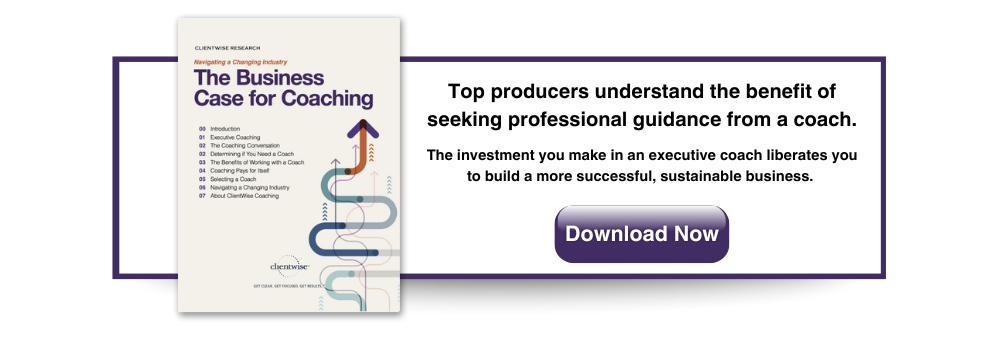9 Trends That Will Impact the Future of Your Firm
Given the ever-evolving advisory landscape, staying ahead of the curve can be a difficult challenge. It will be essential to your continued success. As we look forward to the balance of 2024 and beyond, several key trends appear poised to reshape the industry and redefine how elite advisors operate. From technological advancements to shifting market dynamics, let’s look at nine trends you’ll need to embrace if you hope to thrive in the years ahead. Consider sharing these with your leadership team, discussing each trend as a group to ensure your firm is well positioned.
- Margin Compression: With expenses related to running the business rising, there will continue to be mounting pressure on operating expenses. And for those firms without well-defined structures and discipline to maintain time-allocated budgets related to advising clients, there’s also what I call the ‘carbon monoxide’ of margin compression. Unlike rising costs, you don’t see it daily, but the team feels it.
To combat this margin compression, you need to employ The 40/30/30 Rule to closely benchmark your P&L and ensure the sustainability and profitability of your firm. The rule holds that 40% of gross revenues should be allocated towards professional staff expenses (salaries, benefits, and other compensation) for those professionals on your team who are advising clients (e.g., advisors, planners, analysts). Another 30% should be earmarked for operating expenses related to running the business (e.g., rent, utilities, technology, marketing, and support staff). The remaining 30% is then designated for operating profits.
Adhering to the 40/30/30 Rule will help you more effectively manage resources, maintain operational efficiency, and achieve sustainable growth while still delivering high-quality services to your clients. - Rising Labor Costs: As labor markets tighten and demand for skilled professionals heats up, advisory firms struggle with rising labor costs. To mitigate this challenge, take some time to revisit and potentially upgrade your compensation structures. You can also invest in additional training and development programs and adopt newer technology solutions that can automate routine tasks and improve firmwide productivity.
- Training Lead Advisors: As the search for lead advisor talent grows more and more fierce, having a clearly articulated succession plan has become an increasingly crucial differentiator for leading advisory firms. With more and more firm principals and senior advisors approaching retirement age, training and developing the next generation must be a priority if you wish to attract the best talent to your firm and ensure continuity, client retention, and a seamless transition.
Providing a pathway to achieving valuable technical designations like the CFP®, CFA® and CPWA®—as well as training future leaders to grow the business (e.g., Glenn Mattson’s business development and productivity training offered through Sandler)—are all terrific ways to attract and cultivate future lead advisors. - Private Equity Investors: The financial advisory sector generates significant interest and investment from private equity firms, lured by strong fundamentals and sustained AUM growth. This injection of investment capital into advisory firms is driving consolidation and fueling expansion. Although surging valuation multiples have been a nice byproduct of this capital influx, it’s the innovation that private equity enables which is most helping to drive growth. Private equity in the advisory space isn’t a passing fad. It’s here to stay. So it’s important to familiarize yourself with how private equity partnerships are typically structured and how they can help you scale your businesses. DeVoe & Company’s CapitalWorks can offer insights and support as you explore this potential avenue.
- Succession Planning: Given that the average advisor in the U.S. today is 56 years old,1 succession planning has become a top priority for firms looking to secure their future viability. Whether through internal succession, mergers, or acquisitions, you must develop a comprehensive succession plan to facilitate a smooth transition and preserve client relationships.
ClientWise’s Success In Succession™ Program offers an ideal starting place. Along with guiding to prepare the next generation to take the reins successfully, the program addresses a host of other challenges—from deciding when and to whom you should consider selling equity to understanding the drivers of value, determining the optimal business structure, how and when to seek out an evaluation, and ways to secure favorable financing. - Next-Generation Partners: As client's needs and preferences evolve, financial advisory firms increasingly recognize the importance of diversity and inclusion, including integrating next-generation partners. Embracing diversity in leadership can bring fresh perspectives to your business, help drive innovation, and better position your firm to cater to changing client demographics.
If this is a key area of interest, you might want to check out Claire Meyers Consulting’s Recruiting as a Service (RaaS) They can help set up a recruiting infrastructure for your firm, work closely with your leaders to calibrate candidate profiles, and then source, screen, interview, and manage the selection process for any roles in your organization. - Multiple Expansion: Demand for financial advisory services is rising—leading to potential multiple expansion opportunities for your business, but only if you are growing revenue and profits and improving the quality of earnings for your firm. As investors place a premium on firms with strong growth prospects, robust client relationships, and differentiated service offerings, it’s important to focus on enhancing your value proposition and position your firm as an attractive investment target.
John Furey and his team at Advisor Growth Strategies are doing good work to help firms accelerate growth and maximize outcomes inside and outside the M&A marketplace. - More Rigorous Compliance Oversight: Regulatory requirements continue to evolve, demanding increasingly rigorous compliance and risk management oversight. To meet this demand, your organization must develop a robust compliance framework, stay abreast of regulatory changes, and prioritize ongoing training and education to ensure all firm members adhere to industry standards and safeguard client interests. Increasingly, advisors are turning to expert regulatory and compliance consulting firms like Brian Hamburger’s MarketCounsel to outsource much of the regulatory heavy lifting so that advisors can maximize their time focusing on client relationships.
And coming rapidly to a theater near you, expect increased regulation and requirements to protect your firm, team, and clients from cybersecurity threats. Regardless of firm size, all firms will need to take increased actions to reduce the likelihood of a cyber intrusion while quickly detecting an intrusion and ensuring that your organization is prepared if an intrusion occurs. Ultimately, maximizing your firms’ resilience will become increasingly more vital. Mark Hurley’s new company, Digital Privacy & Protection, provides services to help you be better prepared. They also offer valuable support for your clients, which can increase your value proposition.
- Advancing Technology (AI): Artificial intelligence and advanced technology solutions transform financial advisors' operations—from portfolio management and risk assessment to client communication and marketing. By harnessing the power of AI-driven insights, advisors can now deliver more personalized advice, improve investment outcomes, and enhance client engagement. Pay close attention to the insights from Joel Bruckenstein and his team at T3 Consulting, who I feel have their finger on the pulse of AI and its current and future potential impact on advisory businesses.
If you hope to compete and thrive amid a rapidly changing advisory landscape, you must adapt and embrace these key trends. Be willing to leverage innovation. Commit to investing in talent development. And prioritize client-centric strategies. You’ll be well on the way to success in 2024 and beyond.
Coaching Questions from this Blog
- On a scale of 1-10, how disciplined is your team at defining, measuring, and managing time that’s been intentionally allocated to each segment of client advice?
- How might your team improve its people development plan?
- What do you need to do next to develop the future leaders of your firm?
- How have you engaged clients in your succession planning strategy?
- How will you improve the value proposition of your firm to remain competitive?
1 J.D. Power 2023 U.S. Financial Advisor Satisfaction Study
Topics: Business Planning



